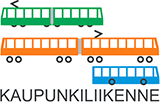Urban rail is currently rarity in Finland. Aside the growth of motoring, commuter train services were closed in Finland to the end of 1970's. The tram system of Viipuri was lost to Soviet Union after World War II and tram of Turku was closed in 1972. Trams and commuter train services survived only in the Helsinki region capital area.
Helsinki region
Helsinki region core is the region of 3 cities, capital city Helsinki, western neighbour Espoo and northern neighbour Vantaa. These cities have co-operated since 1970 in certain public services. In 1986 this co-operation inaugurated regional public transport ticketing system and the purchaser–producer -model, that later became the base of the EU Public transport act. It is, the authority has the responsibility to plan the public transport service, sell the tickets and purchase travelling services from the market of service providers.
Today this co-operation is formed as Helsinki Region Transport authority (HRT), which currently has more member counties than the 3 biggest cities of the region.
As the daily commuting area covers many cities and counties, one responsibility of HRT is to plan and update regional traffic system plan. In this plan the main content is major network parts that cross the county borders. Or which have influence to the travelling of the citizens of the region, not only the county where the item exists. In practice rail network projects tend to be important parts of this regional plan.
Tram
In the general plans of 1960's Helsinki tram system was planned to be closed and replaced with 3 heavy metro lines. Up to 1950's tram network covered the urban area and had expanded also outside the Helsinki borders. After the metro plan the extending of the tram network was cancelled and during the years tram ended up to serve only the densest core of the urban structure. All the suburbs were served with buses or commuter trains.
The urban development in Helsinki ended up to converting some industrial areas near the city centre to housing. City planners wanted to extend tram network into these areas. Together with this and delays in metro building, the closure of tram became cancelled. But extensions to suburbs were not allowed, as that service was reserved for the metro system.

Mäkelänkatu tram route ends to Käpylä where main street is decorated with trees. Käpylä was originally outside the dense urban structure and quite independent suburb. New housing is built nearby, but the tram line has never extended to serve the growth of the city. Foto 2.7.2013 Antero Alku.
Major change happened in the Helsinki master plan in 2010's. New thinking of urban development looked for denser urban structure instead of urban sprawl policy that had dominated before. To help build extension for the urban city structure, new tram lines outside the old city centre were included into the master plan. One key idea was to convert highways to streets with modern tram lines. This was called in Helsinki as ”building boulevards”.
One part of this concept was orbital Light Rail tram line at app. 7 kms distance of the city centre. This line called Joker was invented already in 1990, but realized only in 2016, when the housing minister Kimmo Tiilikainen decided to give state support for building the line. Another big project is the tram line to Laajasalo isle east of Helsinki.
Slightly surprisingly City of Vantaa started to forward also with a tram plan to connect the airport, Vantaa city centre and the north-eastern metro end station. Though separated from the Helsinki tram net, Vantaa tram is planned to be compatible to Helsnki's meter gauge system. Decisions to forward are expected to be done in new city council elected in summer 2021.
Metro
Growing demand for traffic from 1950's forced Helsinki traffic planners to look for more space from underground in the city centre. Originally Helsinki planned to build tunnels under the city centre for long tram trains that operate on ground outside the city. This was similar as what became reality in Germany under the concept Stadtbahn.
During 1960's these plans were cancelled and converted to heavy rail. The dimensioning of the trains was taken from commuter trains, number of stops reduced dramatically, and the concept was a feeder system based on buses.
The background for this turnover was at least partly industry policy. Finnish state owned former airplane factory Valmet wanted to enter urban rail business worldwide with its aluminium body technology. Helsinki would be a pilot case where metro coaches were larger than anywhere but with same weight as smaller steel body coaches.
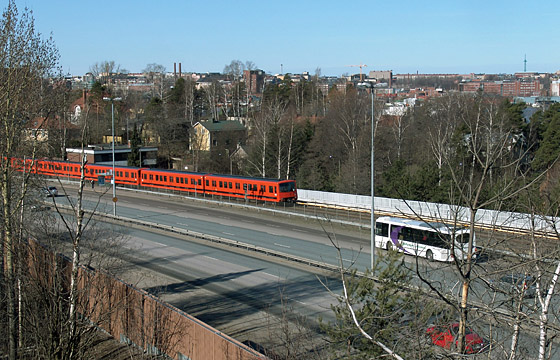
Helsinki metro is a trunk line like a highway for cars. Outside the city centre most passengers need to use feeder bus lines. Buses still operate parallel to the metro line as buses have more frequent stops than the metro. Metro is built beside the highway in original eastern section as geometry does not fit to smaller streets. Kulosaari 4.4.2007, foto Antero Alku.
It took app. 10 years for Valmet to develop a metro train, during which dummy prototype trains operated at the few kilometers track. Prototype trains never entered in commercial service and became scrapped. Commercial service started in 1982.
Major extension of the metro system opened to west in Espoo in 2017, more than 10 years after the decision of the extension. The track is completely in tunnel under sparsely built areas and will end to Kivenlahti app 2024.
Any other extension is not realistic at the moment. The cost in Espoo appeared to exceed over all possible estimates making the system totally uneconomical. At the same time the capacity was cut to 2/3 by building the stations to 90 meter length instead of 130 meters in the old network. A plan to build housing for 80.000 citizens and a metro line to far east of Helsinki became cancelled with the new policy to avoid urban sprawl.
Helsinki metro was originally planned to be driverless and prototype trains operated independently. The series trains with AC propulsion system were unreliable for driverless operation and trains are operated only manually. Conversion to driverless operation was tried again in early 2010's but with no success to convert old trains.
Commuter trains
During 1950's steam locomotives in commuter trains were replaced with light DMU's. In the end of 1960's the electrification of Finnish railways started from a commuter line west from Helsinki to Kirkkonummi. Gradually DMU's became replaced with new generation EMU's with thyristor chopper propulsion system.
Finnish Valmet built EMU's started the new era in Helsinki region commuter services. They were first electric service in Finnish State Railways. But they were also very modern having semiconductor based propulsion control. The left hand side version still in original livery. Foto 22.3.2003 Antero Alku.
Commuter services operate currently to west and north along the main railway lines mostly at separate tracks and on a loop that passes the airport in east-west-direction. Original EMU's were replaced with Stadler Flirt EMU's from 2008. These trains are property of the cities, not of the State Railways company.
Branch line to Martinlaakso was built only for commuter services and opened in 1975. As the line was part of the 1960's metro network plan, the stations were built to be converted to metro coach operation. The conversion was in discussion in 1990's. As a long tunnel required under the northern city centre was too expensive, an idea of a smaller tunnel loop was discovered. This loop is called ”Pisara”, drop, based on the shape of a tunnel starting and ending to Pasila station. Latest plans and evaluations prove even the short drop-tunnel too expensive.
Tampere
Tampere became the fourth city in Finland to operate tram traffic. As a green field project, Tampere tram is based on modern best practices and became a role model for the Helsinki region tram projects already during the construction phase.
Tampere tram also broke a glass roof in Finnish thinking of city and public traffic planning. Tram was in marginal during half a century, when car and heavy rail oriented planning paradigma dominated. So late as 2014, same time as Tampere council decided to start procuring of the tram system, Finnish finance minister decided to finance a heavy rail tunnel instead of a long planned Light Rail line in Helsinki region. But after the Tampere tram project had proceeded succesfully, the next government cancelled the tunnel and pointed financingfor the Light Rail.
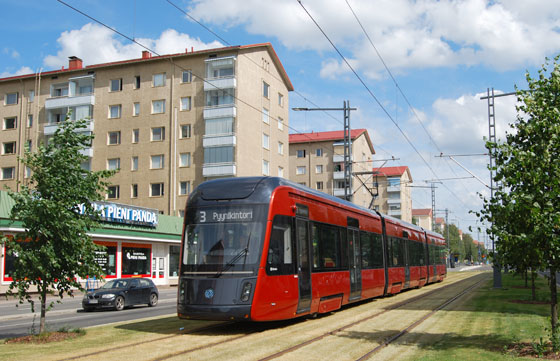
A brand new brick red Tampere tram car at a dried green track on Sammonkatu. July 2021 was very hot and dry when trams served passengers at test traffic before the official opening of the system. Foto 7.7.2021 Daniel Federley.
There were plans to build a tram to Tampere already in 1907. The project proceeded, but the First World War stopped the project in 1914. After the war there were tries to proceed, but private bus companies were faster. Finally the tram project collapsed in 1923 to disagreement of technical features with the contractor.Instead of tram a trolley bus system operated in Tampere 1948–1976. During 1960's there were even plans to build a metro to Tampere.
The city returned to tram in 1990's when use of public transport was decreasing. After many phases the city council decided in 2014 to start procurement for a tram system. Civil engineering works started in 2017.
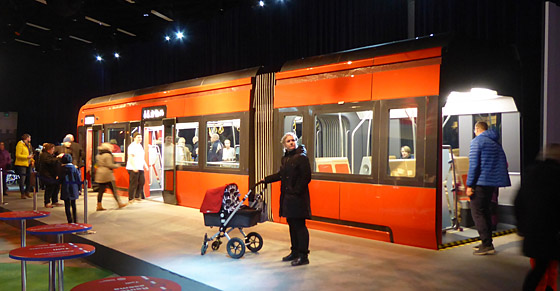
Full size mock-up of half of the coming Tampere trams were on display at Tampere-house at end February 2019. Foto 24.2.2019 Antero Alku.
The first phase of Tampere tram was complited in 2021. Citizens were able to travel in tram first from 10.5.2021 in test traffic at line 3 between Hervanta suburb and city centre. Official start of tram operation at both lines was 9.8.2021.
Tram is a part of a regional agreement of regions development. State supports the infrastructure with 30 %. Technically Tampere tram will be compatible to modern European trams systems with 1435 mm gauge and 2650 mm vehicle width. In the future tram will create a car and bus free inner city, but from the start buses operate at the same lanes with trams.
Look for an article that describes process to build a new tram (in Finnish)!
Turku
City of Turku had a meter gauge electric tram during 1908–1972. Before that Turku had a 1435 mm gauge horse tram only two years from 1890.
Like other European cities, motoring was growing during 1960's and tram systems that were established in the beginning of the century started to be technically outdated and worn out. Turku had purchased 8 new 4-axle trams that came into service in 1956. But the politicians wanted to make space for cars, close the tram system and operate buses. City council decided 1965 to close the tram system.
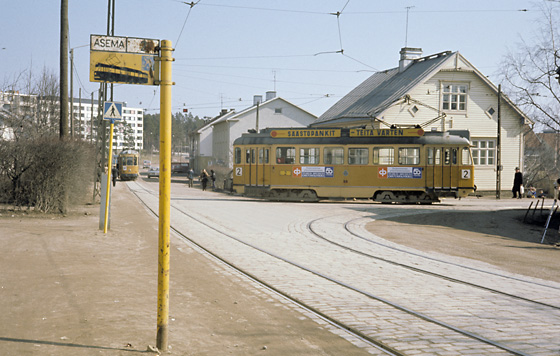
Tram network reached city border in Nummenmäki already in 1938. New housing was built in 1960's to only 600 meters from the end of the tram line. The city plan for new Kurala area included tram loop, but city board refused to finance the short extension in 1962. Foto Mikko Alameri 14.5.1972 in last year of operation.
Citizens of Turku never wanted to stop trams and in 1990's a discussion to return trams to Turku started. Plenty of plans and reports were done and gradually the atmosphere turned towards a new tram system. Still there is strong opposition against tram and final decision to do more than new studies has not yet done.
In 2018 the city management positioned more pro tram and the idea is that city board will propose the council to decide to start to procure a tram system. The project has forwarded since with re-planning the network and adding a branch towards harbour, where new housing development is planned. The new city council elected in summer 2021 may make a decision to forward towards realization fo the tram plans.
Look for an article about the public transport in Turku (in Finnsih)!
Other regions
Helsinki region, Tampere and Turku are the largest and most populated urban areas in Finland. Still smaller populated areas are also interested in trams. This can be considered as a consequence of the city planning paradigm shift away from car oriented city planning. Climate change is also a driver as is the observed decreased interest of motoring and single housing in younger generations.
Oulu in the northern Finland is a university centre and there have been space reserved for trams in city plans between the campus area and city centre. There are also plans to develop the area between city and airport and a tram line could be a backbone for the development.
Jyväskylä in central Finland is also a university city. Jyväskylä is also a railway crossing and there is plenty of built areas and housing in walking distance of current railway lines. City with neighbour counties ordered 2019 a preliminary study of a tram-train system. Tram will run on streets in the city centre and to some locations near the city.
Kuopio is another city in central Finland and it has quite similar ideas as Jyväskylä. Double system trams might operate on railway lines connecting neighbour counties to Kuopio and also Kuopio to a nearby city Iisalmi near 90 kms north of Kuopio.
Third city to study tram-train -services is Lahti which is located 100 kms north from Helsinki. Lahti is a railway crossing too. Two of the branches from Lahti, to Heinola and to Loviisa have only low train volumes but might be suitable for passenger services. The location of the railway station in Lahti is not optimal so a diversion to street network enhances the service quality.
Back to top of page.
Page created 24.7.2019 / AA. Updated 7.8.2021 / AA.
